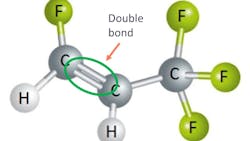Demystifying refrigerant blends for the automotive aftermarket
Auto shop owners are always balancing the performance, ease of use, and cost of mobile heating, ventilation and air conditioning (HVAC) service. With regulations pushing for lower-global warming potential (GWP) solutions and global concern over per- and poly-fluoroalkyl substances (PFAS), it has become clear that a single molecule can no longer do everything. Historically, shop owners have had to compromise on one or more of these factors — until now.
Amid the evolving landscape of vehicle air conditioning systems and the increasing regulatory pressures to phase out higher-GWP refrigerants, automotive service professionals are being forced to look toward next-generation products. From technicians to shop owners, many are asking “what’s next?” knowing they will need to understand and work with newer refrigerant options as the industry pushes toward more sustainable solutions. The answer is refrigerant blends.
The concept of refrigerant blends is not new, having been used in stationary HVAC systems for decades. But most automotive service professionals today are used to working with single-component refrigerants like R-134a. As the industry makes way for more sustainable solutions in the form of blends, let’s explore why they matter to day-to-day operations, their primary benefits, and how they enable both compliance and efficacy.
What is a refrigerant blend?
In contrast to single-component refrigerants which have only one molecule in their structure, refrigerant blends can be composed of two, three, four or even more refrigerants. A blend’s composition and design can optimize performance metrics such as efficiency, cooling capacity and carbon emissions. Formulated for specific performance and sustainability characteristics, blends have become a valuable tool for technicians and manufacturers in their daily work.
One of these characteristics is how quickly the material breaks down in the atmosphere if it leaks. This is the reason hydrofluoroolefins (HFOs) like R-1234ze are so important. HFOs contain a double bond, creating an opening for materials in the air (radicals) to reach the double bond and break the refrigerant molecule apart. This feature makes ZE last for much less time in the atmosphere, but also makes the material more flammable as a result.
Why do we need blends?
The United Nations International Panel on Climate Change (IPCC) has set ambitious targets to cut emissions by 45% by 2030 and achieve net zero emissions by 2050. These goals are crucial to limit global temperature rise to 1.5 degrees Celsius above pre-industrial levels (from the 1870s to 2100), which is the critical threshold for climate change.
Many incumbent single-component refrigerants have already been or are set to be phased out due to high ozone depletion potential (ODP), GWP, or other environmental concerns. Examples of these are R-12 and R-134a. As older refrigerants are phased out, this creates a need for alternative solutions.
R-1234yf, the current mobile incumbent, has low ODP and GWP, but carries a ~10% shortfall in cooling capacity versus R-134a. It also degrades into 100% tri-fluoro acetic acid (TFA), a material of concern in potential PFAS regulation in Europe. YF may also require different system components or additional features due to its A2L mild flammability. Blends have emerged to fill this gap in the marketplace, offering a means to customize properties and performance for various applications like the automotive aftermarket while reducing environmental impact.
What are the benefits of blends? How can they help?
The automotive aftermarket sector is turning to blends to meet regulatory and sustainability criteria and enhance performance. With blends, AC performance (in the form of pulldown time) can actually get better. Research and Development among manufacturers like Orbia Fluor & Energy Materials is developing refrigerant blends to bring these advantages to the market today. As a result, performance no longer has to be a tradeoff for sustainability. In fact, Orbia Flour & Energy Material third-party testing confirmed that performance actually improves:
- R-444A cabin pulldown time is four minutes faster than R-1234yf.
- R-444A can improve fuel economy or EV range through higher efficiency.
- R-444A exhibits the same or better lifecycle carbon performance than R-1234yf in many geographies.
Ease of use and recovery are also key benefits as many refrigerant blends are direct system replacements. Shops, service techs and vehicle owners can rely on the same servicing equipment, gauges and tools, using the appropriate fitting adaptors for the refrigerant. This benefit extends the lifetime of service equipment, limits the need to purchase new machines, and makes life much easier on service technicians by matching a service blend for the incumbent in its flammability class:
- A1: R-134a can be serviced with R-456A (~50% lower GWP, equivalent performance)
- A2L: R-1234yf can be serviced with R-444A (< 150 GWP with higher performance)
What should auto technicians and shops do to prepare for the transition?
To prepare for the transition to aftermarket blends, technicians should review the technical information and handling guidance on new, high-performing blend alternatives like R-444A and R-456A, and talk with technical support staff at refrigerant manufacturers like Orbia Fluor & Energy Materials (Koura).



